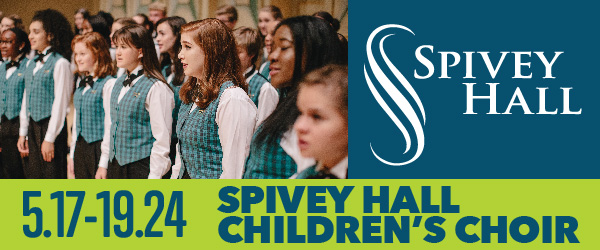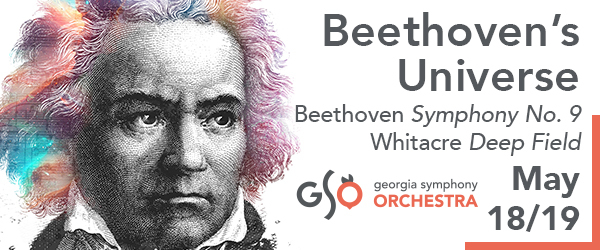Mark Gresham | 28 FEB 2020
Guest conductor Thomas Søndergård returned to the Symphony Hall podium on Thursday for a second week to lead the Atlanta Symphony Orchestra in its second and final “Northern Lights”-themed program of music by Scandinavian composers. While last week’s program was entirely music by Finnish composer Jean Sibelius, this week four different composers shared the bill. Also three guest soloists: pianist Håvard Gimse, baritone Andreas Landin and soprano Sherri Seiden. The program will be repeated Saturday evening at Symphony Hall.
Admittedly I am a “shut up and play” kind of listener, who doesn’t care at all for a conductor speaking from the stage during a concert unless absolutely necessary. Søndergård did both this Thursday and the previous one. Symphony Hall is not kind to speech, even when amplified and from where I sat on bo0th occasions Søndergård’s words simply went by me mostly as sound but not words, so for me the attempt to “connect with the audience” is wasted. This isn’t specific to Søndergård, by the way, rather it is the common experience I’ve had for years when it comes to the audience being addressed from the stage I’d rather conductors not bother, as it doesn’t make them more affable. (There, I’ve said it. Let’s now have the music!)
The music began with the Suite from the 1923 ballet-pantomime Bergakungen (The Mountain King) by Swedish composer Hugo Emil Alfvén (1872 – 1960). The complete ballet-pantomime (cataloged as Op. 37) was a success in Sweden for about a decade after its premiere. Alfvén, who was also active as a conductor, drew the Suite from four of its scenes for concert use. Today, however, much of the music sounds like anonymous film scoring, with a lot of obvious compositional devices of the genre at play. In contrast, the fourth movement, the lively “Vallflickans dans” (“Hay girl’s dance”) from Act III, is a lighter showpiece which orchestras sometimes program alone a charming encore piece. The rest of the Suite, quite frankly, is colorful but not particularly compelling. Though short (just over four minutes), the final movement by itself might be more effective as a curtain-raiser.
The Piano Concerto in A minor, Op. 16 (1868) by Norwegian composer Edvard Grieg is decidedly one of the most popular of piano concertos in the repertoire. Its opening theme has long circulated within American popular culture, enough so that many people recognize it without knowing either the work’s title or the composer’s name. Performances by top-name have graced the Symphony Hall stage a number of times over the years, most recently an April 2016 by Louie Lorte, with Robert Spano conducting, brought the house instantly to its feet.
Unfortunately, that was not the case with Thursday’s performance, which came across as a bit rough-shod in both the solo part (pianist Håvard Gimse) and Søndergård’s handling of the orchestra. Søndergård, here and elsewhere, seems at iimes to go for very had downbeats which begin some sections, as if they needed some kind of over-emphasis to say “here’s a new section.” What was largely missing, though was what one might call an “extroverted elegance” that was a hallmark of the Lortie/Spano collaboration of almost four years ago.
After intermission, baritone Andreas Landin took to the stage to sing a ballad for voice and orchestra, Florez och Blanzeflor, Op. 3, by Swedish composer Carl Wilhelm Eugen Stenhammar (1871 – 1927). It’s a setting of the poem by Oscar Levertin, which recounts s the tale of a royal couple doomed to untimely death. Appealing enough, and a good vehicle for Landin, who would return to the stage with soprano Sherri Seiden to sing in the next piece, the Symphony No. 3, Op. 27, of Danish composer Carl Nielsen – but both only briefly during the second movement (from rehearsal mark [8] through its end) and even then from behind the orchestra (upstage and to the left, from the audience’s perspective). These vocal parts are wordless (an “ah” vocalization is indicated in the score) and are a unique among Nielsen’s six symphonies.
The Symphony No. 3 (aka “Sinfonia Espansiva”) was the highlight of the concert. Starkly powerful unison “A”s were hammered out in the brass, timpani and strings in its first 15 measures, with long silences between them at first, but growing closer together. That set the attention-getting tone for the work. The first movement’s bursting energy was extroverted and affirming; the second was its counter: a blissful idyll, its mood enhance by the two ethereal solo voices emerging from behind the orchestra. The third movement’s unsettled mix of emotions gave way in the finale to a rather straightforward expression of pragmatic happiness thaty comes from of everyday life. Søndergård was at his best in Nielsen’s music, and it showed in the ASO’s performance.
More interesting than the evening’s orchestral music was that of the ASO’s pre-concert chamber recital, which kicked off at 6:45pm on the Symphony Hall stage. The music of four living women composers, all involving harp, was performed by an ensemble of five women of the ASO: Elisabeth Remy Johnson, harp Christina Smith, flute Emily Brebach, oboe Marci Gurnow, clarinet and Jessica Oudin, viola.
The program included The Book of Spells: Chapter I, Love and Relationships, The Siren’s Seduction by Brazilian-American composer Clarice Assad, a new mixed ensemble work commissioned by Remy Johnson; Jhula Jhule by Indian-American composer Reena Esmail, originally for violin and piano but performed here on oboe and harp; Lamentation of the Bird, for clarinet and harp, by Russian-American composer Polina Nazaykinskaya; and a final mixed ensemble piece, Danses Ravissants by American composer and oboist Margi Griebling-Haigh. The program proved a wonderful adventure of discovery. The music of all four of these composers is well worth exploring further. ■
RECENT POSTS
 From pagan ritual to Biblical trial: Spano and ASO explore theme of sacrifice in Stravinsky’s “Rite” and Leshnoff’s “Isaac” • 18 May 2024
From pagan ritual to Biblical trial: Spano and ASO explore theme of sacrifice in Stravinsky’s “Rite” and Leshnoff’s “Isaac” • 18 May 2024 Musical homecoming: ASYO’s 50th-anniversary concert gathers participants from the orchestra’s beginnings to the present • 16 May 2024
Musical homecoming: ASYO’s 50th-anniversary concert gathers participants from the orchestra’s beginnings to the present • 16 May 2024 Chang and Beck’s “Sonatas & Myths” illuminates distinctive styles of Szymanowski, Dohnányi, and Bartók • 14 May 2024
Chang and Beck’s “Sonatas & Myths” illuminates distinctive styles of Szymanowski, Dohnányi, and Bartók • 14 May 2024






.png)